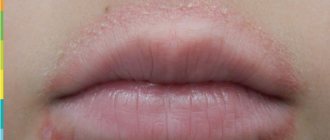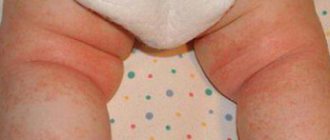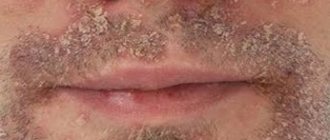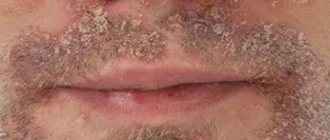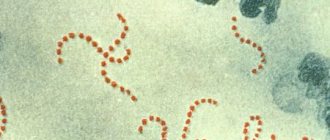Rosacea
Rosacea
is a persistent lesion of the blood vessels of the facial skin. It manifests itself as redness of the skin of the cheeks, nose, forehead and chin, bright pink rashes, spider veins, and pustules. In later stages, irreversible thickening and infiltration of the skin of the nose, forehead, earlobes, eyelids, and chin may develop. Leads to a deterioration in the appearance of the skin, sometimes pronounced cosmetic defects, changes in appearance, and psycho-emotional problems. When the eyes are affected, keratitis and ulceration of the cornea develop.
Previously, the development of rosacea was attributed to the presence of demodicosis, but these two diseases are different in their etiology, although each of them complicates the course of the other. The pathogenesis of the development of rosacea lies in the increased sensitivity of skin vessels. If there is a genetic predisposition or the vessels are fragile and brittle, then in response to irritants such as sudden changes in temperature, dry and hot air, the vessels dilate, which is not observed in the majority of people.
The incidence of rosacea in people with a history of gastritis is much higher than in those in whom Helicobacter pylori, the bacterium that causes gastritis, has not been detected. Rosacea of a medicinal nature is observed with long-term use of corticosteroid ointments; the skin arteries become thinner, become more fragile and sensitive to minor temperature changes.
Risk factors for the development of rosacea
The incidence of rosacea is approximately the same in both sexes, but women during menopause are more susceptible to rosacea, as hormonal levels and vascular properties change. Blondes and redheads with thin, sensitive skin prone to redness are at risk for rosacea. Allergic and contact dermatitis can provoke rosacea, since the blood vessels are often dilated and subsequently their return to their previous state is no longer possible.
Genetically, residents of northern peoples are more predisposed to rosacea; living in extreme continental climates and in northern countries also increases the risk of rosacea.
Diseases and disorders of the endocrine system, diseases of the gastrointestinal tract and disorders of the immune system, especially when combined with each other, lead to rosacea. The pathogenesis of rosacea is not fully understood, but most dermatologists agree that exposure to hot or cold areas, wind, and consumption of excessively burning foods, alcohol and spices provoke rosacea.
Bibliography
- Adaskevich V.P. Perioral dermatitis: clinical picture, diagnosis, treatment / V.P. Adaskevich // Dermatology. – 2008. – No. 1. – P. 17–20.
- Grashkin V. A. Diagnostic criteria, epidemiology and substantiation of clinical and pathogenetic types of perioral dermatitis / V. A. Grashkin, M. S. Gromov // Voenmed. magazine – 2010. – No. 10. – P. 32–45.
- Rodionov A. N. Dermatocosmetology. Lesions of the facial skin and mucous membranes. Diagnostics, treatment, prevention / A. N. Rodionov. – St. Petersburg. : Science and technology, 2011. – 912 p.
- Karelina O. Yu. Perioral dermatitis: treatment with azelaic acid / O. Yu. Karelina, Yu. M. Karelin // Klin. dermatology and venereology. – 2006.
Prevention of rosacea
Since rosacea is a chronic disease, after removing the excess capillary network, it will reappear after some time. Therefore, the prevention of rosacea consists of periodic visits to the cosmetologist’s office to eliminate newly appeared hypertrophied blood vessels. But, if between procedures you avoid overheating and hypothermia of the skin, spend as little time in the open sun as possible, adjust your diet and use cosmetics that contain horse chestnut extract and other substances that strengthen the vascular wall, then you will need to repeat the procedures no more than once every 2 -3 years.
Perioral dermatitis
Perioral dermatitis
- chronic inflammatory lesion of the skin around the mouth in the form of individual or grouped red papules located against the background of normal or reddened skin.
Perioral dermatitis is most often observed in women aged 20 to 40 years. Recently, there has been an increase in the incidence of this type of dermatitis among children.
Prevention
Treatment with ointment for perioral dermatitis is not always a panacea. In some cases, the disease can return, so the course of taking medications can be long. Any irritant often leads to the appearance of the disease. Following simple recommendations will help you avoid possible risks:
- Check the composition of cosmetic products and treat their choice with special attention
- Don't neglect personal hygiene
- Strengthen your immunity
- Eat right and monitor your digestive health
- Be aware of allergies
- Monitor hormonal balance during pregnancy, in case of possible changes due to nervousness, illness or other reasons
Perioral dermatitis detected at the first stage is the easiest and fastest to treat, so remain sensitive to the body’s signals and begin the fight against the first symptoms of the disease in a timely manner.
Causes of perioral dermatitis
The exact causes of perioral dermatitis are not yet known. In many cases, the disease occurs in patients after long-term use of topical medications containing corticosteroids.
The development of perioral dermatitis can be triggered by severe chapping of the facial skin, increased sun exposure, the use of fluoride-containing toothpaste and decorative cosmetics such as makeup base and foundation. In women, a connection between the disease and hormonal changes has been noted: the appearance of rashes during pregnancy and against the background of various gynecological diseases, increased manifestations of dermatitis before the onset of the menstrual cycle. In some cases, perioral dermatitis appears when using oral contraceptives.
Risk groups and similar diseases
Signs of the disease are most often found in women, but children and adolescents periodically experience them due to weakened immunity. In place of the blisters, ulcers often form. When spread over the entire face, it becomes a threat to vision, which is especially important in the situation with children. Therefore, when checking with a specialized doctor about how to treat perioral dermatitis in children, it is worth paying a visit to an ophthalmologist.
In the case of teenagers, the disease may not be detected immediately, because, experiencing hormonal changes, boys and girls often encounter skin problems. Blackheads and acne affect most people, so it can be difficult to notice papules at an early stage. Patients prone to allergies also rarely accurately diagnose the disease. Perioral dermatitis in children is often attributed to hormonal imbalance.
Symptoms of perioral dermatitis
Perioral dermatitis rashes are single or grouped typical spherical papules. They are colored red or red-pink and are located against a background of reddened or unchanged skin. The rash may be accompanied by discomfort, a feeling of skin tightness, burning or itching. But in approximately 25% of cases, patients do not note any subjective sensations.
Rashes with perioral dermatitis are located on the chin, under the nose, in the area of the nasolabial folds, and in the corners of the mouth. Occasionally, the periorbital form of the disease occurs with damage to the skin of the corners of the eyes, lower and upper eyelids, and bridge of the nose.
Perioral dermatitis: symptoms
Symptoms of this disease are small round or oval-shaped papules located primarily around the mouth and on the chin. In some cases, papules, as mentioned above, can be found on the wings of the nose, on the bridge of the nose, on the temples and cheeks, as well as around the eyes. In some cases, papules may be filled with clear fluid.
The color of the papules, depending on the stage of the disease - exacerbation or remission - can vary from pale pink with a bluish tint to bright red. In some cases, papules are accompanied by hyperemia (general redness) of the skin, or may not cause a change in skin color. A distinctive feature of this type of dermatitis is considered to be a characteristic (light) strip of healthy skin around the mouth, which can be up to 4 mm wide. In turn, the localization of papules can be different - from single formations to groups of several pimples with clearly defined edges. In the case of a large number of papules located nearby, the skin becomes rough, which is felt well when touched.
Also, symptoms of perioral dermatitis, especially during an exacerbation of the disease, may include:
- dryness and tightness of the skin;
- skin itching;
- burning.
However, in a large number of cases, patients do not observe or experience any additional concern with dermatitis.
The sooner you start treating oral dermatitis on the face, the easier and faster it will be cured. That is why, when you detect the first signs of a possible disease, you must seek advice from a dermatologist.
.
Initial appointment
An initial appointment with a specialist involves a thorough examination of the patient, as well as drawing up a preliminary medical history (recording complaints, symptoms, concomitant diseases), which allows making preliminary assumptions regarding the cause of the disease. Additionally, tests and other diagnostic measures may be prescribed to clarify the clinical picture and understand how to treat oral dermatitis on the face.
Diagnostics
Diagnosis of this type of dermatitis is necessary as a way to differentiate from diseases with similar manifestations - eczema, herpes simplex, rosacea, etc.
Diagnostic measures in this case include:
- dermatoscopy: allows you to assess the general condition of the skin, the degree of development of pathology through a thorough examination of neoplasms;
- scrapings of skin material from the affected areas: bacterial culture of the test material makes it possible to determine the presence and type of infection (for example, candida);
- Allergy tests for staphylococcus and streptococcus: also allow you to determine the sensitivity of the skin to these agents and identify their presence.
Treatment plan
If the tests confirm the initially suspected diagnosis of oral dermatitis, the treatment prescribed by a specialist will be comprehensive (using ointments and other medications, as well as diet) aimed at eliminating the manifestations of the disease on the face.
The impact on perioral dermatitis on the face when developing a treatment regimen involves two successive stages leading to the gradual disappearance of the rash:
- At the first stage, it is necessary to completely abandon cosmetics (primarily decorative cosmetics) and ointments with corticosteroids. The latter are most often recommended to be discontinued gradually, reducing the dose and quantity, otherwise the so-called “withdrawal syndrome” may occur, which leads to an exacerbation of all existing symptoms - redness, swelling of the face, burning, itching. At this stage, it is most often assumed to use antihistamines (which relieve itching and burning), as well as herbal medications to relieve local inflammation. Additionally, reflexology can be used, which is an effect on active points on the skin of the face, either by simple pressure or with the help of special needles, to reduce the unpleasant manifestations of dermatitis.
- Second stage: after the acute phase of the disease passes, the patient is prescribed antibiotics, which are designed to destroy the infection and are selected taking into account the infectious agent. Antibiotics are taken only under the supervision of a doctor, who has the ability to adjust their composition and dose taking into account the patient’s body’s reaction to them. Particular care should be taken when treating oral dermatitis during pregnancy: in this case, taking antibiotics is contraindicated, and full treatment is possible only after the birth of the child (normalization of hormonal levels is also important). During pregnancy, only partial relief of the symptoms of the disease - burning, itching, etc. - is possible with the use of medications that are safe for the fetus. The same applies to therapeutic measures for dermatitis in children: treatment in this case can only be carried out under the supervision of a doctor, otherwise it can harm the child’s health.
In addition to the described methods of influence, the patient may be recommended:
- strengthen the immune system and take vitamins;
- establish intestinal microflora;
- adhere to a diet: a diet for this type of dermatitis involves avoiding fried, fatty and spicy foods, increasing the amount of vegetables and fruits consumed, and preferring boiled rather than fried foods. During the period of taking antibiotics, you must completely abstain from alcohol.
Treatment result
Most often, if you follow medical recommendations, it is possible to cure perioral dermatitis. In some cases, a course of treatment is assumed rather than a one-time treatment. In this case, taking antibiotics can usually last quite a long time (several weeks), and the overall course of treatment can last from several months to a couple of years.
Prevention
Because dermatitis is a multifactorial disease with an unidentified underlying cause, preventive measures include the following:
- careful use of cosmetics, primarily foundations, as well as ointments based on corticosteroids;
- compliance with personal hygiene measures;
- strengthening the immune system (taking vitamins, reducing psychophysical stress, etc.);
- proper nutrition with plenty of fruits and vegetables;
- monitoring the state of the digestive system;
- control of hormone levels, especially during pregnancy.
When the first signs of the disease appear, you should not wait long, you must seek advice from a specialist, undergo an appropriate examination and begin therapy, since in order to achieve the best results, treatment of oral dermatitis must begin as early as possible - in this case it can be cured in a relatively short time .
You can make an appointment with a specialist at the Energo clinic either by phone or by using a special form for registering patients on the clinic’s website.
Take care of your beauty and health!
Treatment methods
The method of treatment for perioral dermatitis is determined by the attending physician. The duration of treatment may take a calendar month.
Basic recommendations for treatment methods:
- temporary but complete refusal to use cosmetics on the face;
- exclude the use of ointments containing corticosteroids;
- additional moisturizing of the facial skin is required;
- in sunny weather, you should protect your skin from exposure to ultraviolet rays as much as possible;
- try to eat foods containing hot and salty seasonings as little as possible;
- a doctor may prescribe electrolysis of diseased skin areas;
- in some cases, the patient is sent for cryomassage using liquid nitrogen;
- Antibiotics or medications from the imidazole group may be prescribed;
- the patient should start taking vitamins B6, niacin and riboflavin.
In some cases, observation at a dispensary may be required.
Principles of therapy
For a pronounced therapeutic effect, an integrated approach is required in the correction of perioral dermatitis.
It is important to understand that the duration of therapy is quite long and takes from 6 to 8 weeks .
STAGE 1 – strict adherence to these recommendations
- Using fluoride-free toothpastes.
- If a course of external corticosteroids (hormonal ointments) was prescribed, complete use.
- Avoid the use of decorative cosmetics, especially in the rash area.
- Cleansing the skin only with specialized hypoallergenic products. For example, DermaQuest Cleansing Milk for Delicate Skin is designed for daily cleansing of dry, irritated, sensitive and dehydrated skin.
Heals dry and sensitive facial skin, giving the skin a feeling of comfort, cleanliness, and velvety.
- Compliance with a special dietary regimen that excludes the intake of hot, spicy foods and alcohol.
STAGE 2 – dermatological treatment
It is prescribed by a dermatologist after diagnosis and includes individual prescription of antihistamines, diuretics, sedatives, and sometimes antibiotic therapy.
